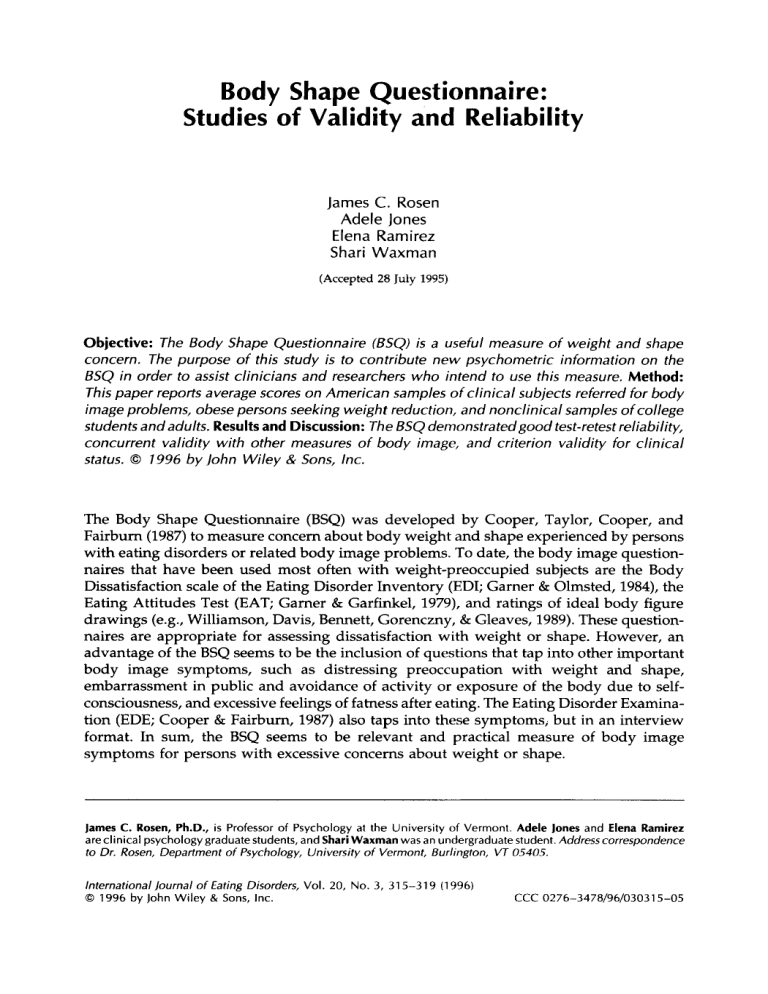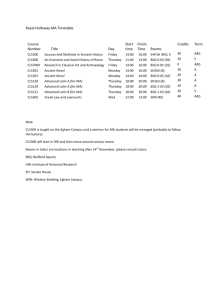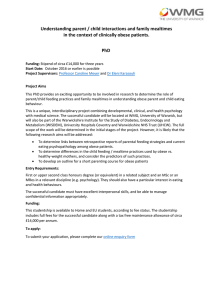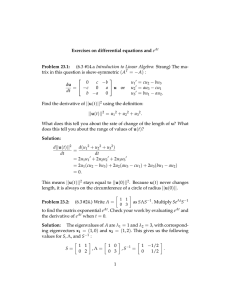
Body Shape Questionnaire: Studies of Validity and Reliability James C. Rosen Adele Jones Elena Ramirez Shari Waxman (Accepted 28 July 1995) Objective: The Body Shape Questionnaire (BSQ) is a useful measure of weight and shape concern. The purpose of this study is to contribute new psychometric information on the BSQ in order to assist clinicians and researchers who intend to use this measure. Method: This paper reports average scores on American samples of clinical subjects referred for body image problems, obese persons seeking weight reduction, and nonclinical samples of college students and adults. Results and Discussion: The BSQ demonstratedgood test-retest reliability, concurrent validity with other measures of body image, and criterion validity for clinical status. 0 1996 by John Wiley & Sons, Inc. The Body Shape Questionnaire (BSQ) was developed by Cooper, Taylor, Cooper, and Fairbum (1987) to measure concern about body weight and shape experienced by persons with eating disorders or related body image problems. To date, the body image questionnaires that have been used most often with weight-preoccupied subjects are the Body Dissatisfaction scale of the Eating Disorder Inventory (EDI; Garner & Olmsted, 1984), the Eating Attitudes Test (EAT; Gamer & Garfinkel, 1979), and ratings of ideal body figure drawings (e.g., Williamson, Davis, Bennett, Gorenczny, & Gleaves, 1989). These questionnaires are appropriate for assessing dissatisfaction with weight or shape. However, an advantage of the BSQ seems to be the inclusion of questions that tap into other important body image symptoms, such as distressing preoccupation with weight and shape, embarrassment in public and avoidance of activity or exposure of the body due to selfconsciousness, and excessive feelings of fatness after eating. The Eating Disorder Examination (EDE; Cooper & Fairbum, 1987) also taps into these symptoms, but in an interview format. In sum, the BSQ seems to be relevant and practical measure of body image symptoms for persons with excessive concerns about weight or shape. James C. Rosen, Ph.D., is Professor of Psychology at the University of Vermont. Adele Jones and Elena Ramirez areclinical psychology graduate students, and Shari Waxman was an undergraduatestudent. Addresscorrespondence to Dr. Rosen, Department of Psychology, University of Vermont, Burlington, VT 05405. international journal of Eating Disorders, Vol. 20, No. 3, 31 5-31 9 (1996) 0 1996 by John Wiley & Sons, Inc. CCC 0276-3478/96/030315-05 Rosen et al. 31 6 The purpose of this study is to contribute new psychometric information on the BSQ in order to assist clinicians and researchers who intend to use this measure. (1) We calculated the test-retest reliability. This coefficient is required to compute the standard error of measurement, (square root of 1 minus test-retest reliability) X standard deviation, which in turn would be required to compute a confidence interval for clinically significant change (Speer, 1992) on the BSQ. The test-retest statistic has not been available. (2) We examined the concurrent validity of the BSQ with the Multidimensional Body-Self Relations Questionnaire (MBSRQ; Brown, Cash, & Mikulka, 1990) and the Body Dysmorphic Disorder Examination (BDDE; Rosen, Reiter, & Orosan, 1995).To date, the BSQ has been validated with measures of weight dissatisfaction (Cooper et al., 1987; Evans & Dolan, 1993),but not with overall appearance concerns as measured by the MBSRQ and BDDE. (3) To date, the BSQ has been studied with young women and bulimia nervosa patients (Cooper et al., 1987;Evans & Dolan, 1993).We examined the BSQ in normal older women and clinic-referredwomen with body image problems who do not have an eating disorder. (4)Because the BSQ is positively correlated with weight (Evans & Dolan, 1993),we thought the measure would be appropriate for body image concerns in obesity. Therefore, we examined the BSQ with various clinical and nonclinical obese subjects, including obese men. (5) Previous studies used British subjects. This report is based on American samples. METHOD Subjects Participants included 466 women and men from four study samples (see Table 1). (1) Body image therapy patients were women who had requested treatment in an outpaTable 1. Body Shape Questionnaire and sample characteristics ~ Body Image Therapy Patients Number of subjects Total Obese Nonobese Age Total Obese Nonobese Body mass index Total Obese Nonobese Body Shape Questionnaire Total Obese Nonobese Number of subjects Age Body mass index Body Shape Questionnaire Obese Dieters University Undergraduates University Staff Women 155 72 83 59 - 163 - - 89 25 64 41.4 (10.0) 41.1 (9.4) 41.6 (9.9) 35.6 (11.4) 40.4 (10.6) 31.5 (10.5) 41.7 (11.0) - 18.5 (1.9) 27.9 (6.9) 33.8 (5.8) 22.9 (2.6) 33.5 (4.6) 21.7 (2.7) - 24.1 (4.7) 34.2 (6.1) 22.5 (2.2) 129.9 (29.0) 135.6 (27.9) 125.1 (29.2) 123.1 (27.9) - 96.3 (32.8) 75.8 (28.4) 97.8 (36.1) 72.9 (28.7) - - - - Men 24 46.7 (8.4) 35.2 (4.4) 86.6 (20.7) - - - - - Note. Statistics for age, body mass index, and Body Shape Questionnaire are means with standard deviations in parentheses. 31 7 Body Shape Questionnaire tient program offering cognitive behavioral body image therapy. They were referred by physicians (psychiatrists, general physicians, cosmetic surgeons) and mental health therapists, or they were self-referred in response to newspaper advertisements. The types of body image problems included body dysmorphic disorder symptoms and weight preoccupation in normal and obese persons. Patients with anorexia or bulimia nervosa were excluded from the study sample. The BSQ had been studied with eating disorder patients previously (Cooper et al., 1987). (2) Obese dieters were men and women who enrolled in a weight reduction program offered by an outpatient health maintenance organization. All subjects were obese, defined as equal to or greater than a body mass index (BMI)of 27.3. (3) University undergraduates were mainly freshwomen introductory psychology students who volunteered for a study on ”gender and self-image” in exchange for extra credit. (4) University staff were female employees who were randomly solicited from the staff telephone directory to participate in a study of self-image.The participation rate was 66% of those contacted. Subjects completed a demographic questionnaire, the BSQ (Cooper et al., 1987),MBSRQ (Brown et al., 1990), and BDDE (Rosen et al., 1995), and were measured for height and weight by a research assistant. Measures were taken prior to treatment in the case of clinical subjects. Because the BSQ seems to tap into stereotypic female weight concerns rather than typical male concerns, it was not administered to male body image therapy and nonclinical subjects. Male obese dieters, who presumably were more concerned with weight, did complete the BSQ. There were sufficient obese subjects among the female body image therapy patients and university staff to divide them into subsamples of obese and nonobese. Because only 5% of the undergraduate women were obese, that sample was not subdivided. Thirty-three undergraduate women were randomly selected for a test-retest reliability sample. The second administration of the BSQ was 3 weeks after the first. Obese dieters and university staff were significantly older than body image therapy patients, who were significantly older than undergraduates, F = 184.8, p < .0001. The age ranges for the three samples of adult subjects (not including undergraduates) were about the same, 20 to 68 years. Nonobese body image therapy patients were younger than nonobese university staff, t (145) = 5.98, p < .001. All four groups differed significantly from each other on BMI, F = 91.9, p < .0001. Obese subjects, including the men, were in the moderately severe obesity range, on average. RESULTS AND DISCUSSION Descriptive Statistics The female groups differed significantly on the BSQ, F = 68.7, p < .0001. In paired comparisons, the body image therapy patients and obese dieters reported more negative body image on the BSQ than the undergraduates who were more negative than the staff. The subsamples of women differed according to main effects of group (body image patients vs. staff) and weight (obese vs. nonobese), F = 139.79,14.63, p < .001, respectively. Post hoc comparisons indicated that all four subsamples differed from each other at p < .05. The male obese dieters reported less negative body image symptoms on the BSQ than the female dieters, t = 6.56, p < .001. These results support the criterion validity of the BSQ in that it differentiatesclinical from nonclinical subjects and persons with predictably more or less weight concern (obese vs. nonobese persons). Rosen et al. 318 In previous studies (Cooper et al., 1987; Evans & Dolan, 1993), young British women from community and student groups averaged 81 and 85 on the BSQ. According to the present findings, American undergraduate women score higher and older community women score lower. The mean score for body image therapy patients is similar to Cooper et ale'sreport of bulimia nervosa patients, indicating that the BSQ should be elevated for women with different types of body image and weight complaints. Obese women report much more distress about weight and shape on the BSQ than nonobese women. However, clinical status is an important consideration with BSQ scores, because the obese body image patients and dieters were significantly more distressed than the obese university employees. Moreover, distress on the BSQ is positively correlated with degree of overweight (see the correlations in Table 2). Test-Retest Reliability The reliability coefficient was .88, p < .001. Reliability coefficients were significant at p < .01 for all 34 items. Concurrent Validity Table 2 reports correlations between the BSQ and other body image measures. The BSQ was strongly related to the BDDE which measures feelings of shame and embarrassment about appearance, excessive importance given to appearance in self-evaluation,and body checking and avoidance behavior. The BSQ also was related to Appearance Evaluation (negative correlations mean that more distress on the BSQ is associated with less positive feelings of attractiveness, i.e., lower scores on the MBSRQ); Appearance Orientation (tendencies to groom and pay attention to one's appearance a great deal); and Body Areas Satisfaction (satisfaction with nine body areas) subscales of the MBSRQ. The BSQ demonstrated good concurrent validity for all clinical and nonclinical samples. These correlations indicate that negative body image attitudes expressed on the BSQ are related to other types of negative body image symptoms, including concerns about nonweightrelated appearance features. In conclusion, these studies show that the BSQ is a reliable and valid measure of body image. Although we found that the BSQ has acceptable concurrent validity for obese men, more information is needed about its appropriateness for men. The descriptive sample Table 2. Correlations of the Body Shape Questionnaire with body mass index and other measures of body image Measure Body Dysmorphic Disorder Examination Multidimensional Body-Self Relations Questionnaire Appearance Evaluation Appearance Orientation Body Areas Satisfaction Body mass index Body Image Therapy Patients .58* - .47* .29* - .53* .19* Obese Dietersa .81* - .66' .58* - .71* .oo University Undergraduates University Staff ,778 .78* - .67* - .59* .28 - .68' .39* .29' - .66' .30* "Male and female subjects were combined because their correlations were equivalent. ' p < .05 (after Bonferroni correction for correlations between the Body Shape Questionnaire (BSQ) and body image measures; unadjusted significance levels for correlations between BSQ and body mass index). Body Shape Questionnaire 319 statistics provided here might be useful for researchers and clinicians who wish to have some standard with which to compare their subjects. REFERENCES Brown, T. A,, Cash, T. F., & Mikulka, P. J. (1990). Attitudinal body-image assessment: Factor analysis of the Body Self-Relations Questionnaire. Journal of Personality Assessment, 35, 134-144. Cooper, P. J., Taylor, M. J., Cooper, Z., & Fairbum, C. G. (1987). The development and validation of the Body Shape Questionnaire. International journal of Eating Disorders, 6, 485-494. Cooper, Z., & Fairbum, C. G . (1987). The Eating Disorder Examination: A semi-structured interview for the assessment of the specific psychopathology of eating disorders. International Journal of Eating Disorders, 6,l-8. Evans, C., & Dolan, B. (1993).Body Shape Questionnaire: Derivation of shortened “alternate forms.” International journal of Eating Disorders, 13, 315-321. Garner, D. M., & Garfinkel, P. E. (1979). The Eating Attitudes Test: An index of symptoms of anorexia nervosa. Psychological Medicine, 9, 273-279. Gamer, D. M., & Olmsted, M. P. (1984). Eating Disorder Inventory. Odessa, FL: Psychological Assessment Resources. Rosen, J.C., Reiter, J., & Orosan, P. (1995). Assessment of body image in eating disorders with the Body Dysmorphic Disorder Examination. Behaviour Research and Therapy, 33, 77-84. Speer, D. C. (1992). Clinically significant change: Jacobson and Truax (1991) revisited. journal of Consulting and Clinical Psychology, 60, 402-408. Williamson, D. A,, Davis, C. J., Bennett, S. M., Gorenczny, A. J., & Gleaves, D. H. (1989). Development of a simple procedure for assessing body image disturbances. Behavioral Assessment, 7 I, 433-446.



